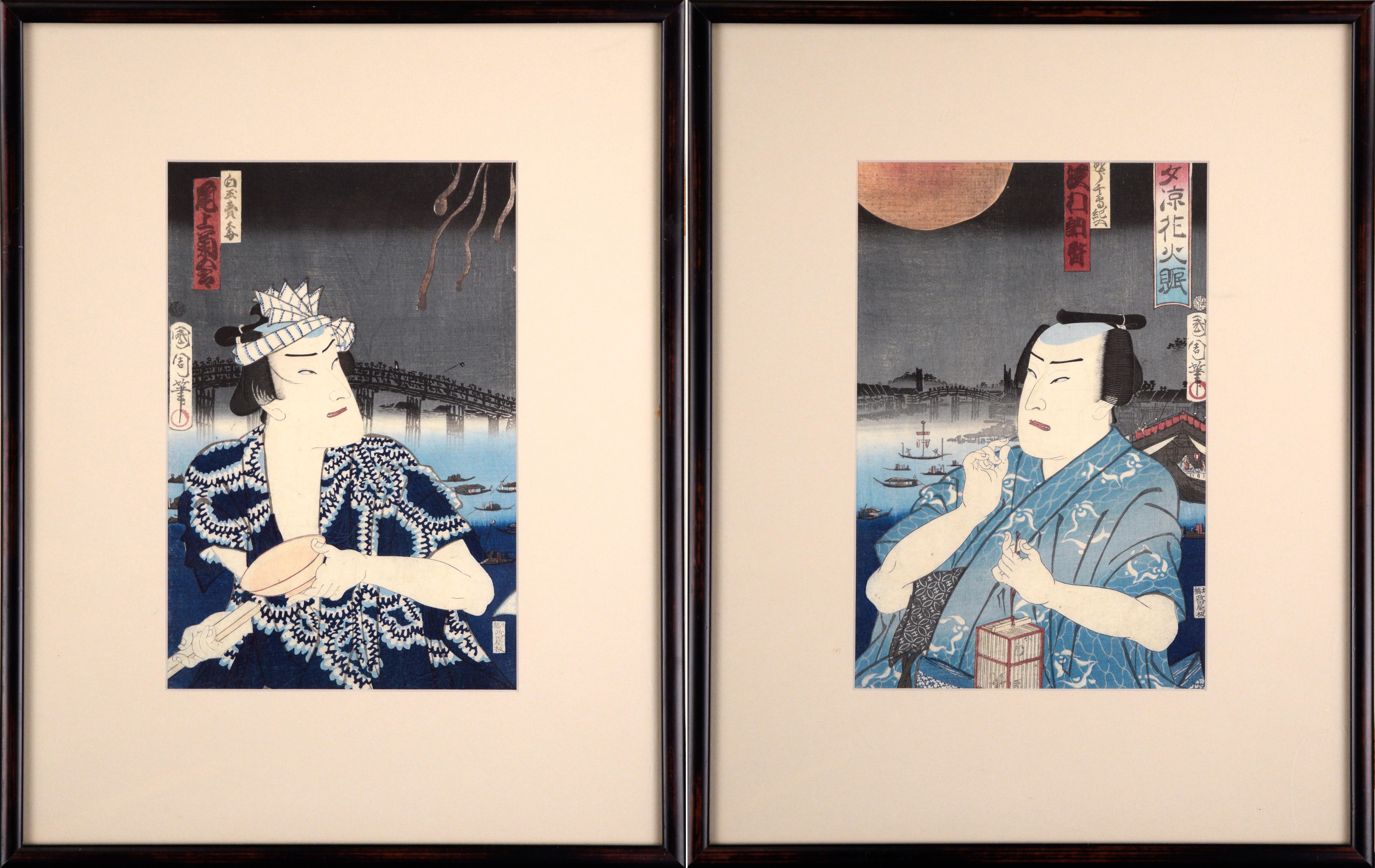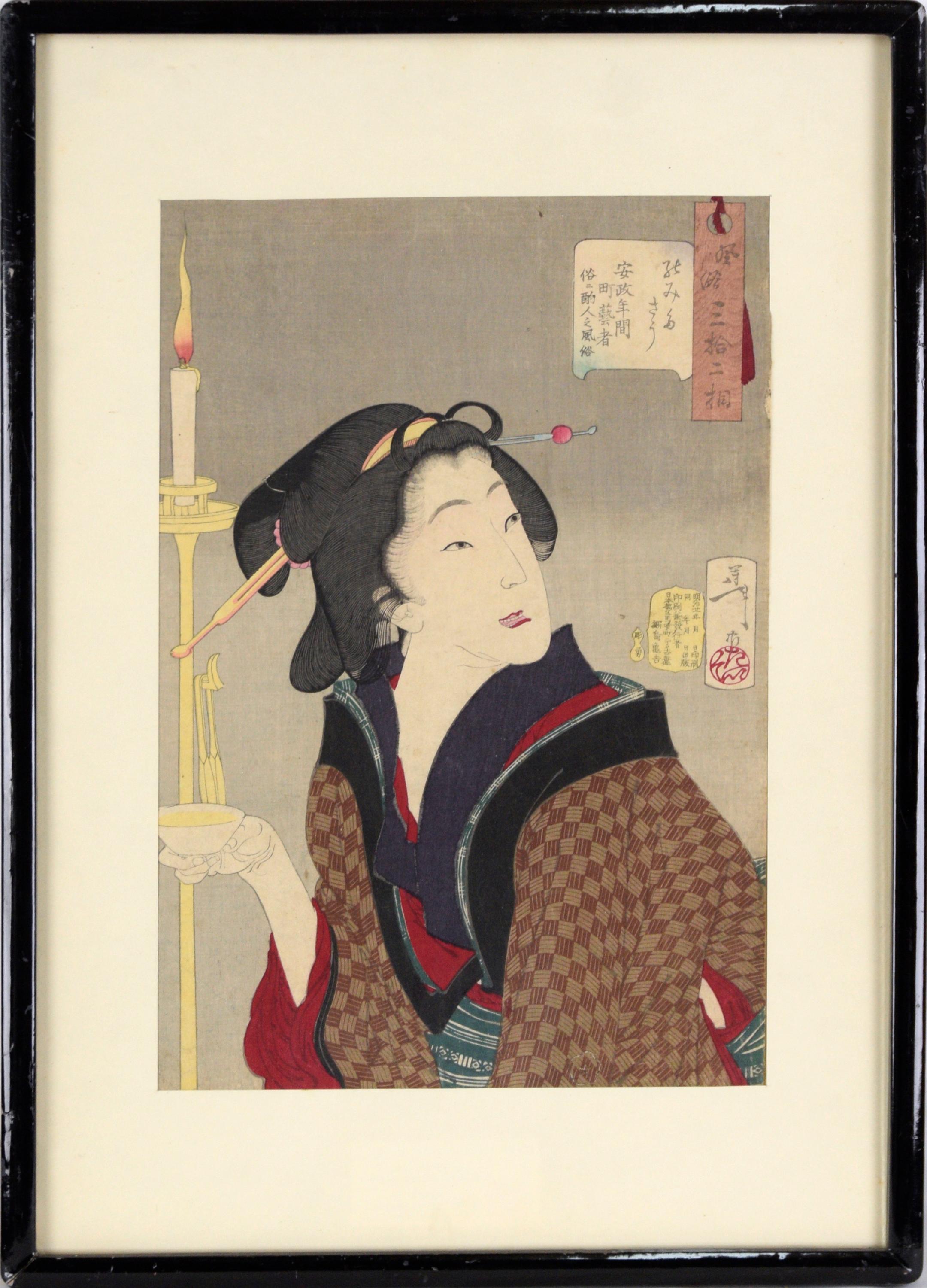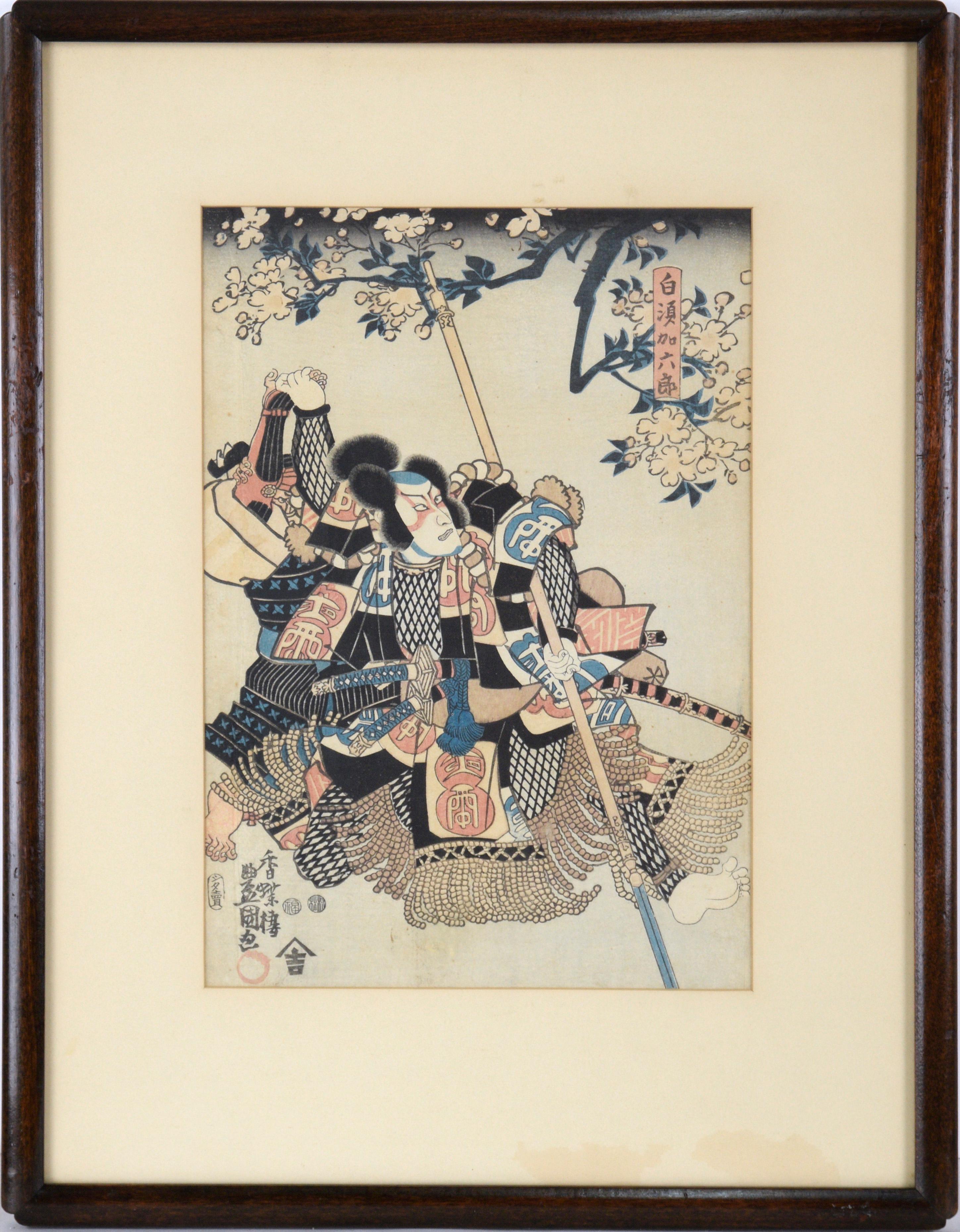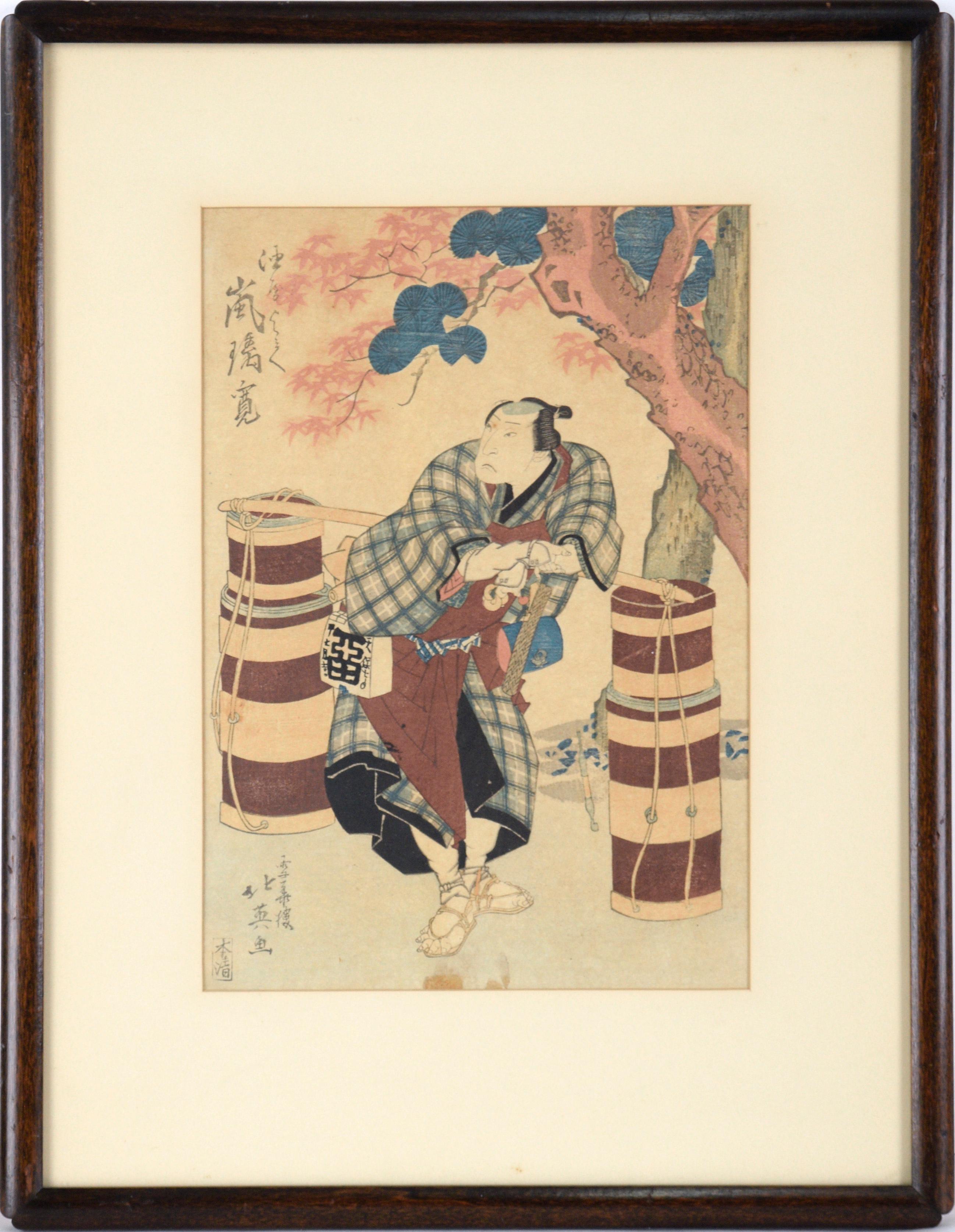Items Similar to Japanese Figurative Edo Woodblock Set of Two
Want more images or videos?
Request additional images or videos from the seller
1 of 17
Toyohara KunichikaJapanese Figurative Edo Woodblock Set of Two1880's
1880's
About the Item
Alluring two-piece edo woodblock print of Japanese actors by Toyohara Kunichika (Japanese, 1835-1900). Titled, dated and signed on verso. Presented in cream mats, with black and red frames and plexiglas. Each frame measures 22"H x 17"W; Image size: 13.5"H x 9"W.
Born in 1835, Toyohara Kunichika grew up in the Kyobashi district of Edo in the midst of merchants and artisans. In 1848, at age 13, he was accepted as an apprentice into the studio of Utagawa Kunisada I (Toyokuni III 1786–1865).
Kunichika's work stands in contrast to that of many of his contemporaries as he persistently held onto the traditional style and subject matter of the classic Japanese woodcut, unaffected by new Western forms of art. His love of Kabuki inspired him to depict actors in their various roles and varying facial expressions. His skillful use of color and ability to translate the actor's depth of emotion onto the page makes his work some of the most dramatic ever produced. Later on in his career, Kunichika turned primarily to the triptych format as the increased size gave him the space to fully portray the drama and action of the characters represented.
- Creator:
- Creation Year:1880's
- Dimensions:Height: 22 in (55.88 cm)Width: 17 in (43.18 cm)Depth: 1 in (2.54 cm)
- Medium:
- Movement & Style:
- Period:
- Condition:
- Gallery Location:Soquel, CA
- Reference Number:
About the Seller
4.9
Platinum Seller
These expertly vetted sellers are 1stDibs' most experienced sellers and are rated highest by our customers.
Established in 1986
1stDibs seller since 2014
2,538 sales on 1stDibs
Typical response time: <1 hour
- ShippingRetrieving quote...Ships From: Soquel, CA
- Return PolicyA return for this item may be initiated within 14 days of delivery.
More From This SellerView All
- Kabuki Actor Diptych, Late 19th Century Figural Japanese Woodblock Prints (Pair)By Kunichika ToyoharaLocated in Soquel, CABeautiful late 19th century Japanese woodblock print diptych of two kabuki actors by Kunichika Toyohara (Japanese, 1835-1900). This pair of prints is united by a continuous landscape...Category
1870s Edo Figurative Prints
MaterialsInk, Woodcut, Paper
- "Thirsty: the appearance of a town geisha in the Ansei era" - Woodblock on PaperBy Tsukioka YoshitoshiLocated in Soquel, CA"Thirsty: the appearance of a town geisha in the Ansei era" - Woodblock on Paper From the series "Thirty-two Aspects of Customs and Manners" (Fuzoku sanjuniso) Lively woodblock of a...Category
1880s Edo Figurative Prints
MaterialsPaper, Ink, Woodcut
- "Plovers at Tamagawa" from "Six Jewel Rivers" - Woodblock Print on PaperLocated in Soquel, CA"Plovers at Tamagawa" from "Six Jewel Rivers" - Woodblock Print on Paper This print, sometimes titled "Chidori No Tamagawa" "Plovers at Tamagawa", is from the series Mu Tamagawa ("Six Views of Tama River", also known as "Six Jewel Rivers" or "Six Crystal Rivers") by Kubo Shunman...Category
Late 18th Century Edo Landscape Prints
MaterialsPaper, Ink, Woodcut
- "Shirasuka Rokuro" - Mid 19th Century Figurative Japanese Woodblock PrintBy Utagawa Kunisada (Toyokuni III)Located in Soquel, CA"Shirasuka Rokuro" - Mid 19th Century Figurative Japanese Woodblock Print Beautiful mid 19th century figural Japanese woodblock print of a samurai named Shirasuka Rokuro by Utagawa Toyokuni III (Kunisada) (Japanese, 1786-1864/5). The samurai is holding a spear, standing under a tree with full blossoms. He is wearing an elaborate outfit, including two swords. Artist's signature and chop are in the lower left corner of the piece. Presented in a wood frame with a cream mat. Frame size: 21.5"H x 16.5"W Image size: 13.75"H x 9.5"W During his lifetime Kunisada Utagawa was considered to be the best print designer by his contemporaries. He was more popular than Hiroshige, Hokusai or Kuniyoshi. And Kunisada was extremely productive. His total output is estimated at more than 20,000 designs, many made by his students. Kunisada was born near Edo (today Tokyo) as the son of an affluent merchant with a ferry boat license. At the age of fifteen he joined the famous art school of Utagawa Toyokuni and took the name Kunisada. In 1807 the young artist produced his first illustrated book. And in 1808 his first actor prints were published. His fame grew fast. While other artists like Kuniyoshi Utagawa or Hiroshige had to fight for recognition for years, he was successful from the beginning. He should become the most commercially successful of all woodblock printmakers ever. His early success may not have had a good influence on his personality. He had a reputation for his conceited personality. Kunisada designed a wide spectrum of traditional ukiyo-e subjects like kabuki themes, beautiful women, historical events and quite a few shunga...Category
1850s Edo Figurative Prints
MaterialsPaper, Ink, Woodcut
- Actor Arashi Rikan II as Aburaya Yohei - Figurative Woodblock Print on PaperLocated in Soquel, CAActor Arashi Rikan II as Aburaya Yohei - Figurative Woodblock Print on Paper Woodblock print of kabuki actor by Shunbaisai Hokuei (Japanes...Category
1830s Edo Figurative Prints
MaterialsPaper, Ink, Woodcut
- Scribe and Personal Assistant to the Shogun - Japanese Woodblock Print on PaperLocated in Soquel, CAScribe and Personal Assistant to the Shogun - Japanese Woodblock Print on Paper Detailed woodblock print by an unknown artist, In the style of Suzuki Harunobu. There are two women i...Category
19th Century Edo Figurative Prints
MaterialsPaper, Ink, Woodcut
You May Also Like
- Seishi Ai-oi Genji – Set of 12 Shunga works together w/astrological commentaryBy Utagawa Kunisada (Toyokuni III)Located in Middletown, NYSet of 12 woodblock prints in colors on handmade, laid mulberry paper, 6 3/4 x 10 1/4 inches (170 x 258 mm), printed in Ka-ei 4 (1851). Each print with minor handling wear, otherwise in excellent condition with bright and fresh color, and with details printed in silver ink. The images themselves contain several illusive characters indicating the publisher which are obfuscated by figures, as intended. Presented loose, as issued. A fine set. The astrological commentary print has a large and meandering blind stamp with a bird and palm frond motif. This print lists various phrases concerning the Twelve Zodiac Animals as historically counted in Japan, and appears to include erotic commentary on the traits of people born under each of the twelve signs. These Shunga images were issued in books that paralleled (in an erotic fashion...Category
Mid-19th Century Edo Nude Prints
MaterialsHandmade Paper, Ink, Woodcut
- Japanese Beauties Enjoy a Full MoonBy Utagawa Kunisada (Toyokuni III)Located in Burbank, CA"Sun, Moon and Stars". Three beauties enjoy a full moon on the veranda of a teahouse or restuarant. The woman on the left kneels and adjusts her lavishly printed kimono. The beauty in the center has her hair down, and behind her is a screen against which shadows are beautifully silhouetted, which adds an air of mystery. The seated woman on the right is perhaps a geisha, as we see a shamisen lying next to her. Before her is a tray with an assortment of foods. One may surmise that the beauties are being compared to the sun, the moon, and the stars. On the left we glimpse a full moon shining over the peaceful bay, and boats at harbor. Original first edition Japanese color woodblock print triptych...Category
1840s Edo Figurative Prints
MaterialsWoodcut, Mulberry Paper
- Drying PaperLocated in Middletown, NYWoodcut on cream laid paper, 7 1/4 x 2 1/2 inches (182 x 63 mm), narrow margins. Laid down to non-archival board with scattered soiling and some adhesive staining. Okumura Masanobu (Japanese 1686 – 13 March 1764) was a Japanese print designer, book publisher, and painter. He also illustrated novelettes and in his early years wrote some fiction. At first his work adhered to the Torii school, but later drifted beyond that. He is a figure in the formative era of ukiyo-e doing early works on actors and bijin-ga ("pictures of beautiful women"). While Masanobu's early life is largely undocumented, he is believed to have been born about 1686, possibly in Edo (modern Tokyo). Edo was a small fishing village when Tokugawa Ieyasu chose it as his administrative capital of the Tokugawa shogunate, and by the early 17th century the city had prospered and its population had grown to half a million. Masanobu appears to have been self-taught painter (though he did study poetry under Tachiba Fukaku); he is not known to have belonged to any artistic school. His early work shows the influence of the Torii school of ukiyo-e painting...Category
Early 18th Century Edo Figurative Prints
MaterialsHandmade Paper, Woodcut
- The Lonely House at Asajigahara.Located in Middletown, NYA scene from a series of ghost stories and spooky rural legends. Tokyo: Matsuki Heikichi, 1896. Woodcut in ink with embossing and hand-coloring in watercolor on handmade mulberry pa...Category
Late 19th Century Edo Figurative Prints
MaterialsWatercolor, Woodcut, Handmade Paper
- Actor Iwai Shigaku as Somenoi in "Denka chaya adauchi"By KuniyoshiLocated in Middletown, NYActor Iwai Shigaku as Somenoi in "Denka chaya adauchi" (Revenge at the Denka Teahouse), by Shigeharu, Ryusai (also called Kuniyoshi) Tokyo: Horie Ichiba Wataki, 1835. Woodcut on la...Category
Early 19th Century Edo Portrait Prints
MaterialsLaid Paper, Handmade Paper, Woodcut
- Two Women Playing Sugoroku from "Comparison of the Customs of Beauties."Located in Middletown, NYA scene from a vanishing Japan. Two Women Playing Sugoroku from "Comparison of the Customs of Beauties."; The Customs and Manners of Women Japan: Matsuki Heikichi, 1891. Woodblock ...Category
Late 19th Century Edo Figurative Prints
MaterialsHandmade Paper, Watercolor, Woodcut
Recently Viewed
View AllMore Ways To Browse
Antique And Artisan
Traditional Set Of Two
Framed Antique Prints Sets
Set Of Antique Prints Framed
Antique Ink Sets
Japan Antiques
Japanes Antiques
Japaneses Antiques
Antique Ink Stand
Japanese Art And Antiques
Antiques And Artisans
Woodblock Print Triptych
Japanese Woodcut Kabuki
Kunisada Actor
Woodblock By Utagawa Toyokuni Iii
Kunisada Triptych
Toyokuni I
Utagawa Toyokuni I





